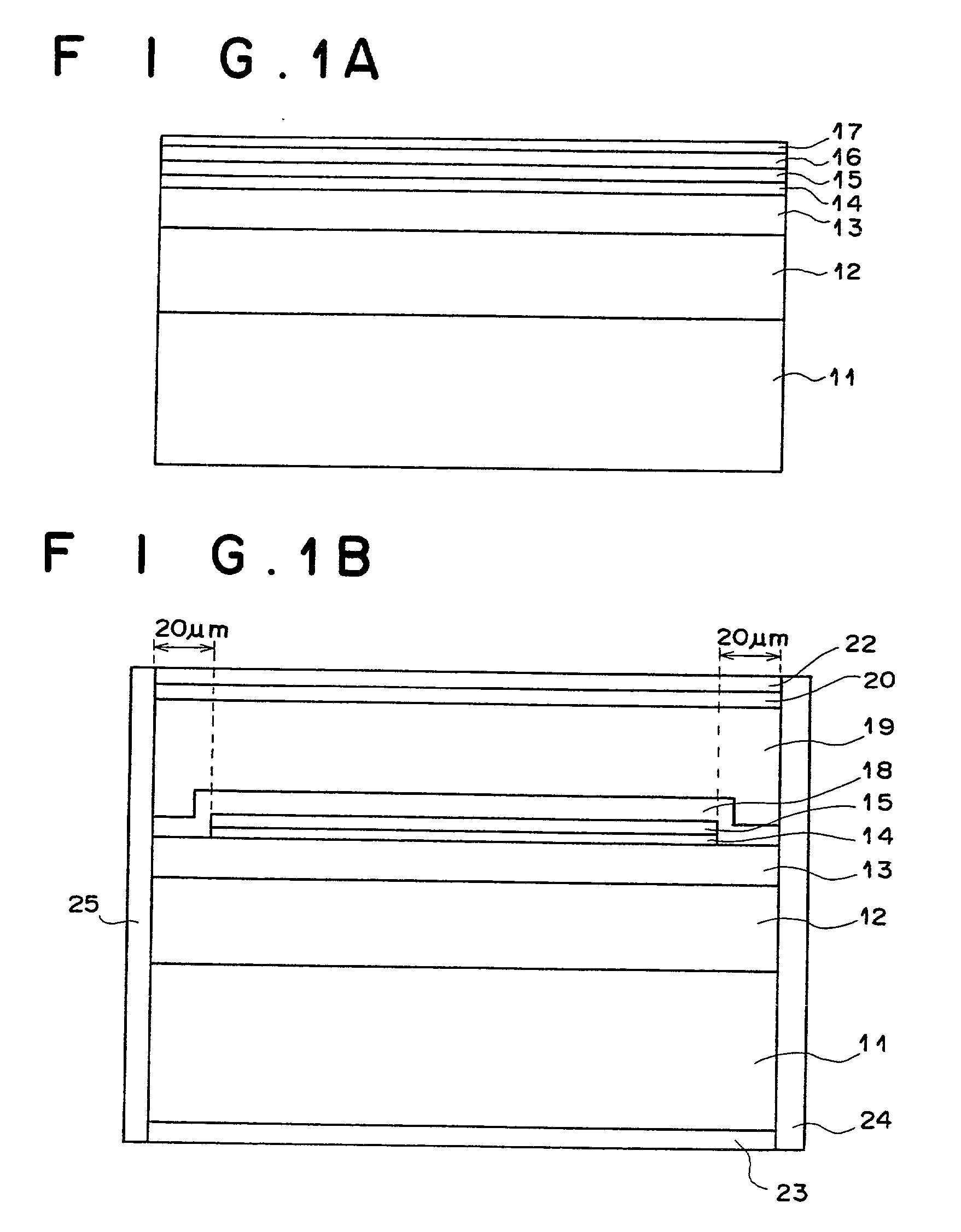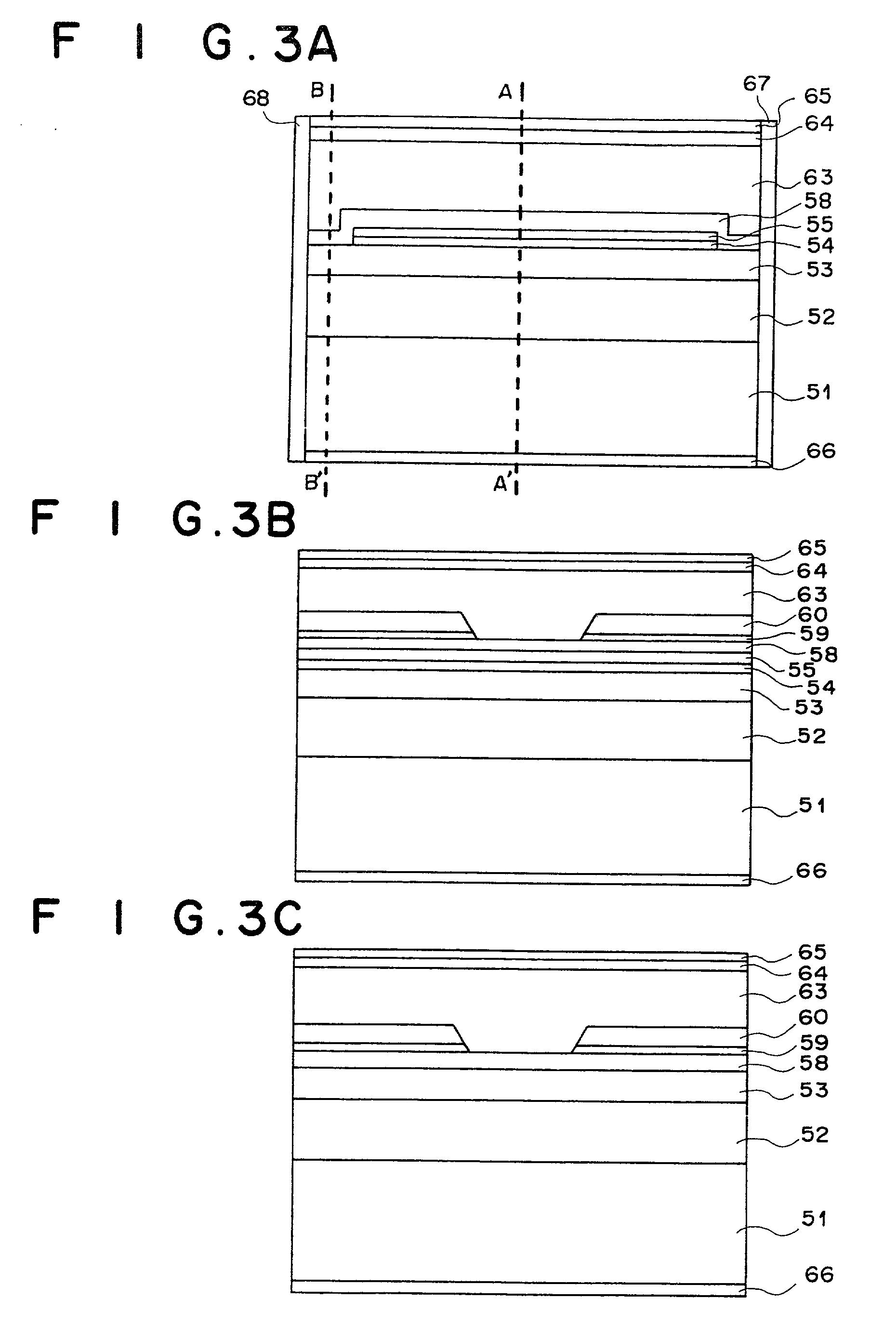High-power semiconductor laser device in which near-edge portions of active layer are removed
- Summary
- Abstract
- Description
- Claims
- Application Information
AI Technical Summary
Benefits of technology
Problems solved by technology
Method used
Image
Examples
first embodiment
[0028] FIG. 1A is a cross-sectional view of a representative intermediate stage in a process for producing a semiconductor laser device as the first embodiment of the present invention, and FIG. 1B is a cross-sectional view of the semiconductor laser device as the first embodiment of the present invention. The cross sections exhibited in FIGS. 1A and 1B are parallel to the direction of the laser light emitted from the semiconductor laser device.
[0029] First, as illustrated in FIG. 1A, an n-type Al.sub.z1Ga.sub.1-z1As lower cladding layer 12 (0.55.ltoreq.z1.ltoreq.0.8), an n-type or i-type In.sub.0.49Ga.sub.0.51P lower optical waveguide layer 13, an In.sub.x1Ga.sub.1-x3As.sub.1-y3P.sub.y3 quantum well active layer 14 (0.ltoreq.x3.ltoreq.0.4, 0.ltoreq.y3.ltoreq.0.5), a p-type or i-type In.sub.0.49Ga.sub.0.51P first upper optical waveguide layer 15, and a GaAs cap layer 16 having a thickness of approximately 10 nm are formed on an n-type GaAs substrate 11 by organometallic vapor phase ...
second embodiment
[0038] FIGS. 2A to 2C are cross-sectional views of a semiconductor laser device as the second embodiment of the present invention. The cross section shown in FIG. 2A is parallel to the direction of the laser light emitted from the semiconductor laser device. FIG. 2B shows the cross section B-B' in the vicinity of the end face, and FIG. 2C shows the cross section A-A' in the central portion of the semiconductor laser device.
[0039] First, as illustrated in FIG. 2A, an n-type Al.sub.z1Ga.sub.1-z1As lower cladding layer 32 (0.55.ltoreq.zl.ltoreq.0.8), an n-type or i-type In.sub.0.49Ga.sub.0.51P lower optical waveguide layer 33, an In.sub.x3Ga.sub.1-x3As.sub.1-y3P.sub.y3 quantum well active layer 34 (0.ltoreq.x3.ltoreq.0.3, 0.ltoreq.y3.ltoreq.0.5), a p-type or i-type In.sub.0.49Ga.sub.0.51P first upper optical waveguide layer 35, and a GaAs cap layer 36 (not shown) having a thickness of approximately 10 nm are formed on an n-type GaAs substrate 31 by organometallic vapor phase epitaxy. T...
third embodiment
[0048] FIGS. 3A to 3C are cross-sectional views of a semiconductor laser device as the third embodiment of the present invention. The cross section shown in FIG. 3A is parallel to the direction of the laser light emitted from the semiconductor laser device. FIG. 3B shows the cross section B-B' in the vicinity of the end face, and FIG. 3C shows the cross section A-A' in the central portion of the semiconductor laser device.
[0049] First, as illustrated in FIG. 3A, an n-type In.sub.0.49(Ga.sub.1-z2-Al.sub.z2).sub.0.51P lower cladding layer 52 (0.1.ltoreq.z2<z3), an n-type or i-type In.sub.0.49Ga.sub.0.51P lower optical waveguide layer 53, an In.sub.x3Ga.sub.1-x3As.sub.1-y3P.sub.y3 quantum well active layer 54 (0.ltoreq.x3.ltoreq.0.3, 0.ltoreq.y3.ltoreq.0.5), a p-type or i-type In.sub.0.49Ga.sub.0.51P first upper optical waveguide layer 55, and a GaAs cap layer 56 (not shown) having a thickness of approximately 10 nm are formed on an n-type GaAs substrate 51 by organometallic vapor phas...
PUM
 Login to View More
Login to View More Abstract
Description
Claims
Application Information
 Login to View More
Login to View More - R&D
- Intellectual Property
- Life Sciences
- Materials
- Tech Scout
- Unparalleled Data Quality
- Higher Quality Content
- 60% Fewer Hallucinations
Browse by: Latest US Patents, China's latest patents, Technical Efficacy Thesaurus, Application Domain, Technology Topic, Popular Technical Reports.
© 2025 PatSnap. All rights reserved.Legal|Privacy policy|Modern Slavery Act Transparency Statement|Sitemap|About US| Contact US: help@patsnap.com



